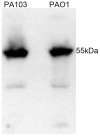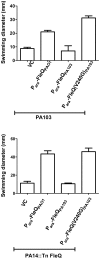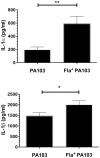A conservative amino acid mutation in the master regulator FleQ renders Pseudomonas aeruginosa aflagellate
- PMID: 24827992
- PMCID: PMC4020848
- DOI: 10.1371/journal.pone.0097439
A conservative amino acid mutation in the master regulator FleQ renders Pseudomonas aeruginosa aflagellate
Abstract
Flagellar-based motility plays a critical role in Pseudomonas aeruginosa pathogenesis, influencing both the establishment of bacterial infection and the host's response to the pathogen. Nonetheless, aflagellate clinical strains are often isolated from acutely and chronically infected patients and include the virulent laboratory strain PA103. We determined that PA103's aflagellate phenotype is the result of a single amino acid change (G240V) in the master flagellar regulator, FleQ. This mutation, which lies just outside the Walker B box of FleQ, abrogates the ability of FleQ to positively regulate flagellar gene expression. Reversal of this seemingly conservative amino acid substitution is sufficient to restore swimming motility to PA103, despite the presence of mutations in other flagellar genes of PA103. We also investigated the consequences of restoring flagellar assembly on PA103 virulence. Although a negative correlation between flagellar assembly and Type 3 secretion system (T3SS) expression has been reported previously, we did not observe downregulation of T3SS expression or function in Fla+ PA103. Restoration of flagellar assembly did, however, amplify IL-1 signals measured during murine pulmonary infection and was associated with increased bacterial clearance. These experiments suggest that loss of flagellar motility may primarily benefit PA103 by attenuating pathogen recognition and clearance during acute infection.
Conflict of interest statement
Figures







Similar articles
-
The Impact of ExoS on Pseudomonas aeruginosa Internalization by Epithelial Cells Is Independent of fleQ and Correlates with Bistability of Type Three Secretion System Gene Expression.mBio. 2018 May 1;9(3):e00668-18. doi: 10.1128/mBio.00668-18. mBio. 2018. PMID: 29717012 Free PMC article.
-
A transcriptional activator, FleQ, regulates mucin adhesion and flagellar gene expression in Pseudomonas aeruginosa in a cascade manner.J Bacteriol. 1997 Sep;179(17):5574-81. doi: 10.1128/jb.179.17.5574-5581.1997. J Bacteriol. 1997. PMID: 9287015 Free PMC article.
-
A four-tiered transcriptional regulatory circuit controls flagellar biogenesis in Pseudomonas aeruginosa.Mol Microbiol. 2003 Nov;50(3):809-24. doi: 10.1046/j.1365-2958.2003.03740.x. Mol Microbiol. 2003. PMID: 14617143
-
fleQ, the gene encoding the major flagellar regulator of Pseudomonas aeruginosa, is sigma70 dependent and is downregulated by Vfr, a homolog of Escherichia coli cyclic AMP receptor protein.J Bacteriol. 2002 Oct;184(19):5240-50. doi: 10.1128/JB.184.19.5240-5250.2002. J Bacteriol. 2002. PMID: 12218009 Free PMC article.
-
Fitting Pieces into the Puzzle of Pseudomonas aeruginosa Type III Secretion System Gene Expression.J Bacteriol. 2019 Jun 10;201(13):e00209-19. doi: 10.1128/JB.00209-19. Print 2019 Jul 1. J Bacteriol. 2019. PMID: 31010903 Free PMC article. Review.
Cited by
-
NAIP proteins are required for cytosolic detection of specific bacterial ligands in vivo.J Exp Med. 2016 May 2;213(5):657-65. doi: 10.1084/jem.20151809. Epub 2016 Apr 4. J Exp Med. 2016. PMID: 27045008 Free PMC article.
-
Modulation of flagellar rotation in surface-attached bacteria: A pathway for rapid surface-sensing after flagellar attachment.PLoS Pathog. 2019 Nov 4;15(11):e1008149. doi: 10.1371/journal.ppat.1008149. eCollection 2019 Nov. PLoS Pathog. 2019. PMID: 31682637 Free PMC article.
-
Recombinant Pseudomonas Bionanoparticles Induce Protection against Pneumonic Pseudomonas aeruginosa Infection.Infect Immun. 2021 Oct 15;89(11):e0039621. doi: 10.1128/IAI.00396-21. Epub 2021 Jul 26. Infect Immun. 2021. PMID: 34310892 Free PMC article.
-
Evidence for intracellular Pseudomonas aeruginosa.J Bacteriol. 2024 May 23;206(5):e0010924. doi: 10.1128/jb.00109-24. Epub 2024 Apr 10. J Bacteriol. 2024. PMID: 38597609 Free PMC article. Review.
-
The Impact of ExoS on Pseudomonas aeruginosa Internalization by Epithelial Cells Is Independent of fleQ and Correlates with Bistability of Type Three Secretion System Gene Expression.mBio. 2018 May 1;9(3):e00668-18. doi: 10.1128/mBio.00668-18. mBio. 2018. PMID: 29717012 Free PMC article.
References
-
- Lyczak JB, Cannon CL, Pier GB (2000) Establishment of Pseudomonas aeruginosa infection: lessons from a versatile opportunist. Microbes Infect 2: 1051–1060. - PubMed
-
- Bardy SL, Ng SY, Jarrell KF (2003) Prokaryotic motility structures. Microbiology 149: 295–304. - PubMed
-
- Mattick JS (2002) Type IV pili and twitching motility. Annu Rev Microbiol 56: 289–314. - PubMed
-
- O'Toole G, Kaplan HB, Kolter R (2000) Biofilm formation as microbial development. Annu Rev Microbiol 54: 49–79. - PubMed
Publication types
MeSH terms
Substances
Grants and funding
LinkOut - more resources
Full Text Sources
Other Literature Sources

